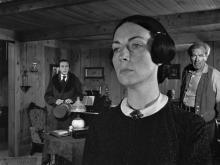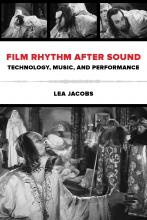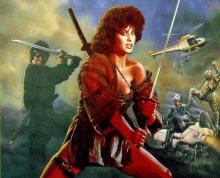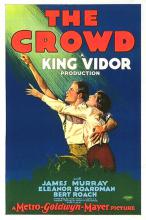This essay discusses Orson Welles' The Magnificent Ambersons and The Stranger and was written by UW Alum and former Cinematheque staff member Evan Davis. The Magnificent Ambersons screens in the Cinematheque's regular venue, 4070 Vilas Hall, on Saturday, January 31 at 7 p.m., followed at 8:45 p.m. by The Stranger. Both films will screen in original 35mm prints.
So much of The Magnificent Ambersons has passed into the realm of myth. Orson Welles's second feature carries with it the inglorious reputation of potential unfulfilled, its lost elements never to be recovered. Joseph McBride has claimed that its original form, before the butchers at RKO got their hands on it, was likely to be "the greatest American film made up to that point," and it would be hard to argue, based on what remains. Citizen Kane certainly announced Welles to the world, but Ambersons was much closer to his heart. As a tragic and nostalgic portrait of Midwestern America—a time just before Welles's birth—the film is a heartbreaking elegy to lost time. But, of course, RKO didn't see it that way.
The history of Ambersons' fate is labyrinthine. A great many factors contributed to its final form and theatrical release. For many decades, however, RKO had successfully tarred Welles as a tyrant gone mad, wasting the studio's time and money on something pretentious and unentertaining. It was their job, RKO argued, to bring him to heel. The studio system was at the height of its power in 1941 and 1942, when Ambersons was being made. But as film historian and UW alum Douglas Gomery has demonstrated, Welles should be better understood as an independent filmmaker working within Hollywood. After all, he had his own production unit inside RKO. He wrote, produced, directed and starred in his own projects. His first contract guaranteed him final cut, a rarity for directors at the time. Welles enjoyed making mainstream art, but didn’t have much interest or gumption for being part of the economic structure offered by Hollywood.
Welles worked on numerous projects at once, rather than take on one film at a time. While filming Ambersons, he co-wrote, produced, and starred in Journey into Fear, shot simultaneously. He started developing an omnibus, It’s All True, a documentary about Brazil made at the behest of the Roosevelt administration. All of these projects, including Ambersons, happened in the months after the release of Citizen Kane—an extraordinary amount of work, especially considering that Welles was also producing radio and theater throughout that whole period. John Ford and Howard Hawks were great artists; one-man bands, they were not.
So, how did Citizen Kane become a sensation, while Ambersons was shunted to the dustbin of movie history? First and foremost, Welles negotiated away his right to final cut in order to get It’s All True made in the timeframe both he and RKO demanded. Second, he wasn’t in Hollywood to personally oversee the editing of Ambersons; he was down in Rio de Janeiro filming It’s All True. Third, editor Robert Wise was supposed to fly to Brazil with a workprint so that he and Welles could work on the film together; that never occurred, either due to flight restrictions during the war or because RKO prevented it. Fourth, RKO production chief George Schaefer was ousted and replaced by Charles Koerner in June 1942, who famously issued a memo with the letterhead, “showmanship, not genius.” No more stinging a rebuke to Welles and those who protected him could have been uttered. When all was said and done, Wise, along with assistant director Fred Fleck, business manager Jack Moss, and actor Joseph Cotten, had cut almost 40 minutes from the film, along with rewriting and re-shooting a great many scenes, including the ending.
The myth has persisted—strongly under the lasting influence of RKO’s publicity machine—that Welles was profligate in his handling of both Ambersons and It’s All True, and therefore the studio was justified in their behavior. Gomery even agrees with Ambersons’s editor and re-shoots director, Robert Wise, in claiming that the studio made the right decision in re-cutting and re-shooting the film. We’ll never know the answer, as the studio destroyed the footage. What we can evaluate is the remaining work, which remains a powerful, emotionally rich and tragic elegy to the power of memory and history, as told through a group of lovely, damaged people.
Welles couldn’t get a job as a director for over three years after Ambersons and It’s All True fell apart. His next mission was to demonstrate (though he didn’t have to) that he could bring a movie in on time and under budget—in other words, be a Hollywood filmmaker. The project he settled on was The Stranger (1946), a thriller set in a small Connecticut town about a government agent (Edward G. Robinson) trying to smoke out a Nazi (Welles) hiding in plain sight, just after the end of the war. The film is notable for being one of the first (if not the first) to use footage from Nazi concentration camps, and its appearance toward the film’s end is jarring and raw. Indeed, it is a documentary flourish with which Welles was often preoccupied, as seen in the “News on the March” sequence from Citizen Kane and the masterwork that is F for Fake. The Stranger is Welles at his most Hollywood, but its grotesque, warped vision of small town America, its political leanings, and its comically over-the-top violence render it very much of a piece with Welles’s narrative and thematic interests. Almost 30 minutes was cut from the film by producer Sam Spiegel, so not even Welles’s most Hollywood picture could be saved from the cutting room floor. By all appearances, this is his least significant work. But William Friedkin recently declaimed, quite emphatically, that The Stranger “is NOT minor Welles!!!” I am inclined to agree. At the very least, enjoy the four-minute lateral tracking shot that marks a murder in the woods, and Edward G. Robinson’s incredibly fun performance. The Stranger was Welles’s first thriller, but it certainly would not be his last.










